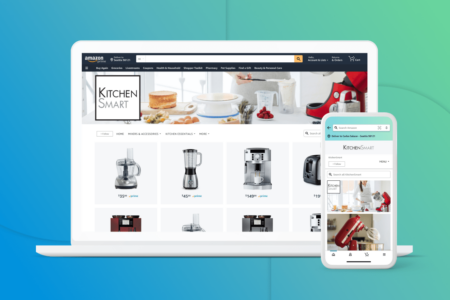As a business owner or marketing manager looking to improve the performance of your website, you must balance the technical elements and on-page content to not only attract new visitors, but also create a winning user experience that encourages conversions.
But without a methodology to actively review how audiences interact with your online presence, how are you supposed to build rewarding strategies and measure their performance?
Fortunately, these already exist in the form of Google Core Web Vitals.
In this article, the team at Clearwater explores what Core Web Vitals are in more detail, how they impact your user experience and SEO performance, as well as some valuable strategies to improve your scores.
What are Core Web Vitals?
Core Web Vitals are a key set of performance metrics Google reviews to measure the fundamental aspects of a user’s experience on your website. While each has a unique makeup, core web vitals primarily measure a site’s loading speed, interactivity, and visual stability.
There are three Core Web Vitals:
- Largest Contentful Paint (LCP): Measures how quickly a page loads and how long it takes for the main content to become visible. The metrics will typically measure the speed at which the largest elements on your page load, such as videos and images.
- First Input Delay (FID): Measures the speed at which browsers can process event handlers after user interaction. In simpler terms, this metric reviews how soon users can begin interacting with a page for the first time without waiting for all the content to load.
- Cumulative Layout Shift (CLS): Measures the time until a page becomes visually stable, signalling how often users experience unexpected layout shifts while interacting with its various features – potentially stopping them from reviewing the rest of the content available.
Other Web Vitals & Signals Reviewed by Google
The Core Web Vitals list is a subset of the wider Web Vitals that Google will apply to each web page.
Other metrics include:
- Mobile-friendliness
- Safe browsing (no malware present on your pages)
- HTTPS
- No intrusive interstitials (pop-ups)
Why are Core Web Vitals Important for SEO & User Experience?
In 2021, Google officially announced their growing focus on user experience (UX) and a page’s relevance within a given industry, concluding that core web vitals are now prominent ranking factors in search algorithms. While there are several hundred other ranking factors, websites scoring well on their Core Web Vitals may see an improvement in their ranking positions on search engine results pages (SERPs).
As such, improving user experience has now become an essential aspect of Search Engine Optimisation (SEO) campaigns.
Google made this shift to better understand how a website performs in helping an audience receive answers to queries, complete functions, and simply deliver a superior experience compared to alternatives available online.
While search engine traffic is one of the main sources of web traffic, this now plays a significant role in not only how many people are driven to your landing pages, but also how they interact with them. Visitors are far more likely to make a conversion – completing a purchase, downloading a resource, leaving an enquiry – if they receive a frictionless site experience that easily directs them to where they need to go.
By placing adequate resources and attention behind Core Web Vitals and user experience, not only can you improve your SERP ranking, but potentially also your conversion rates.
Measuring Core Web Vitals
If you already have a website up and running, it’s likely you won’t have to start from scratch in optimising your Core Web Vitals scores. Instead, the best place to begin is to measure your page’s performance with the metrics described above and build a tailored strategy to address and improve them.
So, how do you measure Core Web Vitals?
There are a few methods:
Search Console
Given how it was Google who placed this user experience priority upon us, they have kindly provided the tools to review our Core Web Vitals scores through Search Console.
Website owners can access a dedicated report that will evaluate each page’s performance across their entire site, and even find notifications on pages requiring specific attention.
PageSpeed Insights
Google also offers PageSpeed Insights, which provides detailed information about FID, LCP, and CLS for each page and more. Users will find issues displayed for both mobile and desktop views, with drop-down boxes available to offer recommended solutions.
Chrome UX Report (CrUX)
The Chrome UX Report (also known as CrUX) is a report built on a public dataset of actual user experience statistics from millions of different websites. This report includes metrics on field versions for each of the Core Web Vitals, ensuring that users can utilise real-world and timely data, rather than data generated from a ‘lab’.
Methods to Improve Core Web Vitals
With an understanding of what Core Web Vitals are and the means to assess your score, let’s take a look at some proven strategies for improving your performance.
Change Your Web Hosting Provider
Your chosen web hosting provider will impact your site’s performance in myriad ways, including security, layout, and page speed. As such, before taking the magnifying glass to the backend of your website, it pays to take a step back and first review the performance of your provider in terms of your Core Web Vitals score.
For example, many sites have a slower loading time because their hosting provider operates on an overcrowded, shared hosting platform. If this was the case with your site, you could rapidly improve your LCP score by upgrading to a dedicated server.
Caching Content
Traditionally, when someone visits your website for the first time, their browser will need to request the data to be sent over from the origin server, which should only take a few seconds. There are, however, several factors surrounding the content and makeup of your pages that can slow the retrieval process, such as if there is a collection of large files or videos. Geographical distance can also create slower load times.
Caching your content is one of the most effective solutions for overcoming this issue and reducing the amount of load time required by your server. When a user visits your website, their browser will save specific files to its cache so that it doesn’t have to load them again during future visits.
You can utilise a caching tool or plugin to instruct the storage of static HTML versions of your website’s pages. Popular options include:
Utilise a Content Delivery Network
Given the role geographical distance plays in load speeds, many website owners invest in a Content Delivery Network (CDN), which provides access to servers stationed worldwide that can store your online content. When someone chooses to visit your site, rather than waiting for a connection, they will be partnered with the server in closest proximity to them, producing the content with much faster loading times.
This is a standard method for improving LCP within your Core Web Vitals, and can be easily achieved with a selection of third-party tools or even as a service offered by your hosting provider.
Remove Render-Blocking Elements
Each site likely has a collection of HTML, CSS and JavaScript files necessary to leave all elements on a page completely visible. The issue is, however, that these files will also contain various scripts that often prevent a web page from being displayed until other elements have loaded.
If you have a selection of third-party plugins and tools connected, such as Google Analytics and other reporting platforms, then you may notice a slowed UX and underperforming Core Web Vitals scores.
To remedy this, you will need to remove such render-blocking elements and ‘minify’ (minimising the code and markup) of CSS and scripts.
If you are savvy with the backend of your website, you can start to minify JavaScript and CSS by removing the blank spaces or comments that aren’t necessary to the wider function. If not, there are tools that you can use to make the minification process much more manageable.
Deferring the Loading of JavaScript
Another popular method for removing render-blocking elements and improving your FID performance is by deferring the loading of JavaScript.
By taking the content from the main CSS file and introducing it directly into your code, your page will load the other content on the page when a visitor arrives, instead of being forced to wait until the JavaScript has fully loaded. Doing this will see your web pages load faster as it delays or ‘defers’ the JavaScript.
Image Optimisation
Images are an excellent way to break up the content on your page and inject some contextual visuals into your pages. Unfortunately, if they are overly large or not in the ideal file type, that could impact your LCP scores.
Fortunately, it is a relatively simple process to optimise and compress your images into smaller file sizes without compromising their quality.
If you have added various images by code, take care to define their dimensions; the bigger the image, the larger its file size will be. Selecting appropriate dimensions for your images will help browsers better allocate the necessary space for each element on your page, reducing layout shifts.
If you upload images via your Content Management System (CMS), you will automatically be assigned the preferred dimensions.
To make things easier, you can also review a range of image compression tools that will allow you to reduce the file size of your images without losing any quality.
Adopt ‘Lazy Loading’
While ‘lazy loading’ might not sound like something you want to introduce into your website, it can significantly improve page speeds. Rather than having all images and content pieces load as soon as a visitor finds their way onto your pages, they will only load once the user reaches the point of the web page in which they are located.
This likely won’t require any code adjustment, as most web hosting providers will offer built-in lazy loading features, such as WordPress’s image optimisation plugin, Smush.
Ensure Your Website Fonts are Optimised
Similar to how images impact loading times, so, too, can your chosen fonts. You might have yet to give much thought to the font on your web page, instead focusing more on the content itself. Still, browsers will need to download a particular font family to display certain choices, including all their weight combinations variations.
It can be a tricky problem to manage when looking to improve your Core Web Vitals score. For example, browsers often won’t render text elements until the web font has fully loaded. Should you place a fallback font in place, however, you may experience a series of layout shifts, subsequently harming your CLS score.
To optimise your fonts, select ‘Web Safe Fonts’ where possible, which are a typeface viewable on both mobile and desktop devices. Web Safe Fonts will typically already be pre-installed on Operating Systems, such as ‘Arial’, ‘Times New Roman’ and ‘Calibri’, precluding the need for further download.
Discover More Methods to Improve User Experience with Your Online Platforms
As Google’s search algorithm becomes more inclined to favour sites with greater UX offerings, improving your Core Web Vitals score will only become more important in securing the top spots of SERPs.
Unfortunately, this won’t be a once-off adjustment you can make to your site.
Instead, modern businesses need to continuously refine their user experience as an element of ongoing website maintenance. While a selection of tools and plugins are available to make this task easier, a keen understanding of the changes in the wider industry is crucial to creating successful campaigns.



